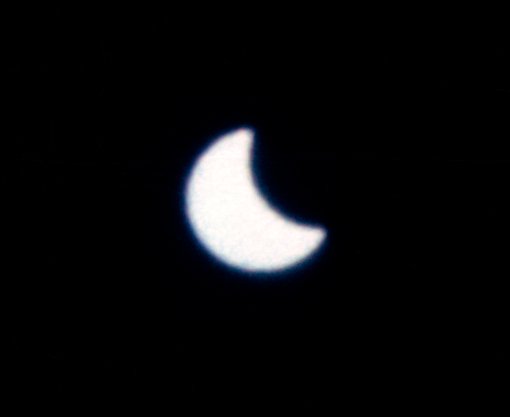solar eclipse of November 12, 1966 on:
[Wikipedia]
[Google]
[Amazon]
 A total
A total
 A total
A total solar eclipse
A solar eclipse occurs when the Moon passes between Earth and the Sun, thereby obscuring the view of the Sun from a small part of the Earth, totally or partially. Such an alignment occurs during an eclipse season, approximately every six mon ...
occurred on November 12, 1966. A solar eclipse
A solar eclipse occurs when the Moon passes between Earth and the Sun, thereby obscuring the view of the Sun from a small part of the Earth, totally or partially. Such an alignment occurs during an eclipse season, approximately every six mon ...
occurs when the Moon
The Moon is Earth's only natural satellite. It is the fifth largest satellite in the Solar System and the largest and most massive relative to its parent planet, with a diameter about one-quarter that of Earth (comparable to the width of ...
passes between Earth
Earth is the third planet from the Sun and the only astronomical object known to harbor life. While large volumes of water can be found throughout the Solar System, only Earth sustains liquid surface water. About 71% of Earth's sur ...
and the Sun, thereby totally or partly obscuring the image of the Sun for a viewer on Earth. A total solar eclipse occurs when the Moon's apparent diameter
The angular diameter, angular size, apparent diameter, or apparent size is an angular distance describing how large a sphere or circle appears from a given point of view. In the vision sciences, it is called the visual angle, and in optics, it ...
is larger than the Sun's, blocking all direct sunlight, turning day into darkness. Totality occurs in a narrow path across Earth's surface, with the partial solar eclipse visible over a surrounding region thousands of kilometres wide.
The path of totality cut a swath across South America
South America is a continent entirely in the Western Hemisphere and mostly in the Southern Hemisphere, with a relatively small portion in the Northern Hemisphere at the northern tip of the continent. It can also be described as the sou ...
from north of Lima
Lima ( ; ), originally founded as Ciudad de Los Reyes (City of The Kings) is the capital and the largest city of Peru. It is located in the valleys of the Chillón, Rímac and Lurín Rivers, in the desert zone of the central coastal part of ...
, Peru
, image_flag = Flag of Peru.svg
, image_coat = Escudo nacional del Perú.svg
, other_symbol = Great Seal of the State
, other_symbol_type = National seal
, national_motto = "Firm and Happy f ...
, passing the northeastern tip of Chile
Chile, officially the Republic of Chile, is a country in the western part of South America. It is the southernmost country in the world, and the closest to Antarctica, occupying a long and narrow strip of land between the Andes to the eas ...
, Bolivia
, image_flag = Bandera de Bolivia (Estado).svg
, flag_alt = Horizontal tricolor (red, yellow, and green from top to bottom) with the coat of arms of Bolivia in the center
, flag_alt2 = 7 × 7 square p ...
,
Northwest of Argentina
Argentina (), officially the Argentine Republic ( es, link=no, República Argentina), is a country in the southern half of South America. Argentina covers an area of , making it the List of South American countries by area, second-largest ...
, southwestern tip of Ñeembucú Department
Ñeembucú (; Guaraní: ''Ñe'ẽmbuku'') is a department located in the south of the Eastern Region of Paraguay. The capital is Pilar. The department is almost entirely rural, and is home to some of the oldest and best-preserved Jesuit ruins, ...
in Paraguay
Paraguay (; ), officially the Republic of Paraguay ( es, República del Paraguay, links=no; gn, Tavakuairetã Paraguái, links=si), is a landlocked country in South America. It is bordered by Argentina to the south and southwest, Brazil to t ...
, nearly to the southernmost tip of Brazil
Brazil ( pt, Brasil; ), officially the Federative Republic of Brazil (Portuguese: ), is the largest country in both South America and Latin America. At and with over 217 million people, Brazil is the world's fifth-largest country by area ...
.
Observations
The NASAGemini XII
Gemini 12 (officially Gemini XII) With Gemini IV, NASA changed to Roman numerals for Gemini mission designations. was a 1966 crewed spaceflight in NASA's Project Gemini. It was the 10th and final crewed Gemini flight (Gemini 1 and Gemini 2 wer ...
mission observed this total eclipse from space:
The Canary Island controller greeted the crew in the morning with the news that there would be a second maneuver - 5 meters forward - to line the vehicles up properly. The prospects panned out richly, and the crew reported seeing the eclipse "right on the money at 16:01:44 g.e.t." Although the crew thought for a moment that they were slightly off track, their aim had actually been accurate.The 28 October 1966 launch of the U.S. Air Force's Orbiting Vehicle 3-2 (OV3-2) was timed such that it could observe ambient charged particle variations before, during, and after the eclipse.
Related eclipses
Solar eclipses of 1964–1967
Saros series 142
Metonic series
Notes
References
{{DEFAULTSORT:Solar Eclipse Of November 12, 1966 1966 11 12 1966 in science 1966 11 12 November 1966 events